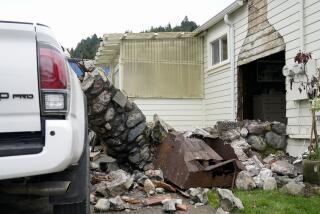System Already Used to Protect Rockets : Lightning Net Hopes to Predict Strikes
- Share via
TULLAHOMA, Tenn. — Lightning remains a natural mystery, but scientists are using a national network to determine quick as a flash where the next bolt might strike.
The benefit, say these latter-day Ben Franklins, would lie in protecting computers, rockets and high-tech experiments. In the long term, a lightning monitoring network might one day predict the next strike and save lives.
“You wouldn’t believe how much juice is flying out there in just one day,” said U.S. Navy Capt. Peter Vanderwolf, secretary to the Working Group for Lightning Detection Systems, based at the Arnold Engineering Development Center, the Air Force research facility in this Tennessee town.
Average Death Toll 97
At least 68 people died from lightning strikes in 1986, and the national average is 97 deaths a year, according to the National Climate Data Center in Asheville, N.C.
A detection system will help scientists better understand lightning, the sky-splitting flashes caused by the discharge of atmospheric electricity from one cloud to another or between a cloud and the earth.
The system also has applications in aviation, communications, weather forecasting and power transmission.
Under the project, 75 antennas have been set up across the United States, with 25 more to be added by next summer.
Multiple Data Recorded
The 10-foot-tall sensors track lightning by monitoring electromagnetic energy--recording the strength of strikes, whether they’re positively or negatively charged, and whether they’re moving in one direction.
The antennas provide information to three regional lightning tracking systems, which form the national network.
Richard Orville, chairman of the Atmospheric Studies Department at the State University of New York, said the three systems, a West Coast network run by the U.S. Bureau of Land Management, a Midwest system owned by the National Severe Storms Laboratory and an extensive East Coast network operated from the New York university, are linked via telephone lines.
Can Predict Direction
Since July 30, a central computer, in Albany, N.Y., has tracked all the lightning flashes in the coverage areas, recording each on magnetic tape, Orville said.
While this network will never be able to tell scientists precisely where the next bolt will strike, it will indicate which direction lightning is headed. An educated guess is better than none, scientists say.
“Lightning is bad stuff; it kills a lot of people. That was one reason we decided a national network was needed,” said Vanderwolf.
The Defense Department, the Department of Commerce, parent agency of the National Weather Service, and other federal agencies are working on the project.
The network tells scientists within seconds where lightning has hit, within two miles of the strike.
Networks Linked
Orville came up with the idea to link three existing networks to his computer instead of building a whole new system.
“We can tell where lightning has hit within nine seconds of when it strikes,” said Orville. “Now we can track storm systems over many hundreds of miles, whereas before you could only see them for 10 or 20 miles.”
Not covered by the network are Hawaii, North Dakota, South Dakota, Minnesota, Iowa and Missouri, along with parts of Nebraska, Arkansas and Texas. They either have very limited lightning sensing systems or simply were not part of any of the three merged regional systems and have not yet been linked.
Alaska has its own lightning tracking system run by the U.S. Bureau of Land Management, but it is not tied to the network’s computer, officials said.
15 Million Recorded
The national network has recorded more than 15 million flashes on tape, Orville said.
“Our computers assign characteristics like the location, the number of strikes in the flash, estimate of the peak current in the flash and they tell us whether a negative or positive flash is brought to the ground,” he said.
The Arnold research center here has used the system to monitor lightning in the Southeast since 1984. Researchers need to know when lightning is headed their way in order to protect test rockets filled with as much as 55,000 pounds of solid fuel, said Blake Powers, a spokesman for the base where stages of the Peacekeeper missile are tested.
Test Chief Uses Data
“It’s been useful, very useful,” said Maj. Terry Hall, chief of test operations at Arnold.
The lightning tracking network is a model, which Vanderwolf said the government will evaluate for three years.
Along the way, some glitches need to be corrected, said Don MacGorman, a physicist at the National Severe Storms Laboratory in Norman, Okla.
“We think the system detects only about 70-80% of the lightning that actually hits the ground and there are errors in location as well,” he said. “The best accuracy you could expect over the entire network would be in a range of two miles.”
Improved, the system could help utilities determine where to send crews to work on power lines, he said. Foresters could use it to tell whether lightning started fires.
Danger to Rockets Foreseen
“The network will be useful just for the information it could provide over a long time to learn how often lightning strikes a particular area,” MacGorman said.
The National Aeronautics and Space Administration uses the network, as well as its own similar system, to watch for lightning strikes that could endanger rockets or sensitive equipment.
Hugh Christian, a NASA scientist at the Marshall Space Flight Center in Huntsville, Ala., and a member of Vanderwolf’s working group, is working on a device called a lightning mapper that will track all lightning via satellite.
He hopes that satellite can be launched in the mid-1990s. “When that happens we expect the two sets to go hand in hand to provide enhanced coverage,” Christian said.
More to Read
Sign up for Essential California
The most important California stories and recommendations in your inbox every morning.
You may occasionally receive promotional content from the Los Angeles Times.










